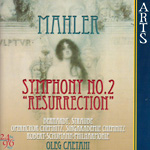It’s been said that Mahler’s “Resurrection” is the ultimate audiophile symphony. Well, this new Arts Music release certainly adds a manner of validity to that claim, as this probably is the noisiest Mahler Second on disc. The percussion section unquestionably is the star of the performance: from the blistering timpani playing throughout to the crushing bass drum and tam-tam blows that open the finale, these guys are on their game, and they’re not the least bit timid about showing it. The wide-ranging recording captures all of this glorious pounding with complete fidelity, presenting a solid three-dimensional sound image, one that’s a bit stingy with reverberation, instead placing the listener in a tight, close perspective relative to the musicians.
The rest of the orchestra acquits itself handsomely, though it must be said that the Robert Schumann Philharmonie is certainly not a world-class ensemble. However, what it lacks in virtuosity and polish (the strings are a bit rough and scrawny), it makes up for in earnestness and commitment. Oleg Caetani launches the first movement at a very measured pace, playing the rapid string figurations with great deliberation as if to make sure each of the notes is evenly articulated. The first movement as a whole (and much of the rest of the performance) is quite weighty, with Bernstein-like slow tempos but without that conductor’s intensity of expression.
The Andante is curiously muted, except for the animated yet still slow-paced central section. A quicker tempo enlivens the scherzo, which really heats up with the central brass episode and climax (though the pastoral trio could use more imagination and instrumental color), bringing the movement to an impressive close. After Monika Straube’s impassioned, dark-voiced “Urlicht” we reach the real heart of this performance when the fifth movement blasts onto the scene with the aforementioned percussion supported by excellent work from the brass. Caetani creates a real sense of anticipation with the massed choir’s wonderfully hushed tones (they also sing out resplendently in their tutti passages) and ideally-judged offstage brass. Straube and Hélên Bernardy intertwine beautifully in their radiant duet.
However, the symphony’s peroration points up the limitations of the engineers’ close-up, narrow-soundstage approach. There’s not enough space around the soloists, chorus, and orchestra to get a sense of their physical positioning. Instead you hear them all piled on top of each other in a rather congested presentation (perhaps a future surround-sound version might correct this?). On the other hand you can clearly hear the usually-inaudible organ playing the main theme just before the final cadence, after which comes the (surprisingly restrained) applause, indicating that this was live performance.
In the final analysis, this release doesn’t match the breathtaking sonic realism of the recent Delos SACD with Andrew Litton and the Dallas Symphony. Litton also outshines Caetani interpretively, as do Bernstein, Slatkin, Neumann, Gielen, Ozawa, and others, making this release far from a top recommendation. But if what you want is a “hi-fi” Mahler Second that’ll rock your world at the climaxes, this one will do the job nicely.
































